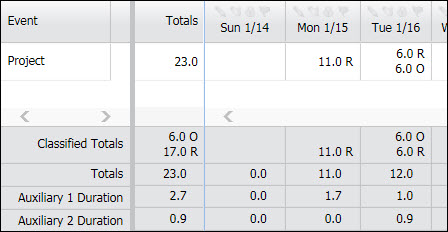Like the Add Bonus Hours with Cap operand, this operand specifies that a maximum number of auxiliary hours can be calculated for the day, week, or period. However, this operand calculates the auxiliary hours across all Auxiliary Durations.
Parameters:
Multiplier = Decimal amount that will be multiplied by the transaction hours to get the auxiliary hours. You can use the Multiplier parameter to determine the auxiliary hours based on the duration. For example, if an employee is scheduled to work 8 hours but should be paid for 9 hours, then the multiplier will be 0.125 (8 * 0.125 = 1). Likewise, if an employee is scheduled to work 6.5 hours and will be paid for 8 hours, the multiplier will be 0.230769.
Basis = Indicates whether auxiliary hours will be calculated for a Post Date, Pay Week, or Pay Period. The default value is Post Date. The transaction durations will be summed over the Basis.
Cap = Maximum number of auxiliary hours that can be calculated for the day, week, or period. Once the number of auxiliary hours for the day, week, or period reaches this cap, no more auxiliary hours will be added.
Auxiliary Number = Select the number of the Auxiliary Duration column in the trans_action_duration table where you want to store the auxiliary hours. For example, select 1 to use the auxiliary1_pay_designator column. This number will indicate which column in the Transaction Duration form will display the auxiliary hours (Auxiliary 1 Duration, Auxiliary 2 Duration, etc.).
Pay Designator = Enter the Pay Designator to assign to the auxiliary hours. This value will be displayed in the Auxiliary Pay Desg column in the Transaction Duration form based on the Auxiliary Number parameter (Auxiliary 1 Pay Desg, Auxiliary 2 Pay Desg, etc.).
Example:
In this example, the multiplier for the auxiliary hours is different depending on the day of the week. Regular and Overtime hours go into different Auxiliary Durations, but the auxiliary hours are calculated across all Auxiliary Durations. There is also a daily cap on auxiliary hours. This configuration requires multiple rules.
IF:
Is Nth Scheduled Day( Pay Week, 2 )
And
Is Hours Class( O )
THEN:
Add Bonus Hours With Cap All Aux Columns( 0.16521739, Post Date, 1.9,
2, AX2 )
And
Stop Processing( )
IF:
Is Nth Scheduled Day( Pay Week, 2 )
And
Is Hours Class( R )
THEN:
Add Bonus Hours With Cap All Aux Columns( 0.16521739, Post Date, 1.9,
1, AX1 )
And
Stop Processing( )
IF:
Is Scheduled Day( )
And
Is Hours Class( O )
THEN:
Add Bonus Hours With Cap All Aux Columns( 0.15652174, Post Date, 1.8,
2, AX2 )
And
Stop Processing( )
Is Scheduled Day( )
And
Is Hours Class( R )
THEN:
Add Bonus Hours With Cap All Aux Columns( 0.15652174, Post Date, 1.8,
1, AX1 )
And
Stop Processing( )
On day 1 of the pay week, the employee posts 11 Regular hours and receives 1.7 hours in Auxiliary Duration 1. The last rule shown above is used.
On day 2, the employee posts 6 Regular and 6 Overtime hours.
The 6 Regular hours receive 1 hour in Auxiliary Duration 1 (the second rule above is used). The rule has a daily cap of 1.9 auxiliary hours, but the cap has not yet been reached.
Next, the 6 Overtime hours are calculated (using the first rule above). The duration for the day is now 12 hours, which yields 2.0 hours for Auxiliary Duration 2. Because the auxiliary hours are being calculated across all Auxiliary Durations, the 1.0 hours in Auxiliary Duration 1 are subtracted from this amount for a total of 1.0 hours in Auxiliary Duration 2. However, there is a cap on the day of 1.9 auxiliary hours. Therefore the 6 Overtime hours only receive 0.9 hours in Auxiliary Duration 2.
